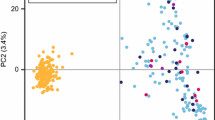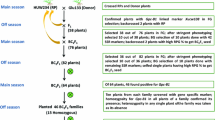Abstract
The results of developing new bread winter wheat starting material using interspecific crosses in breeding for increased protein content are presented. The study comprised 35 initial (2–4 crosses with modern cultivars) and 20 advanced (five and more crosses with modern cultivars) introgression lines of bread winter wheat, and nine genotypes characterized by increased relative protein content and groups of lines that combine relatively high indices of thousand grain weight or protein content with resistance to leaf or stem rust and alien glume hairiness were isolated. The significant effect of lines grouping for the number of crossings with modern cultivars on the productivity, protein content, and the sedimentation value, and the effect of cross combinations, in particular, sources of alien traits, on protein content and thousand grain weight were found. It is shown that higher protein content, observed at the backcrossing, does not always correlate with the improvement of flour quality. The improved lines showed a low frequency of combining the traits of high protein content, large grain size with high productivity, and grain quality. No correlation of the most-studied traits with protein content and weak positive correlation (r = 0.28*…0.30*) of thousand grain weight with both the quality characteristics, sedimentation and protein content, were found. The line productivity had negative correlation with protein content (r = –0.43*) in only one variant of the experiment. The lines B241_09, E2792_14, E1598_12, and Od.267b were isolated, which had relatively higher protein content and combined moderate resistance to certain diseases with relatively high indices of the productivity and sedimentation. The isolated lines are characterized by instable productivity and other properties in different environments and require improved stability of these characteristics. Created on the basis of cv. Odeska 267, the quasi-isogenic lines with resistance to leaf rust (E2363_14, E2368_14, and E2369_14) had higher productivity, protein content, and thousand grain weight than recurrent cv. Odeska 267 on a low agricultural background. Using interspecific hybridization and further complicated step crosses with the elements of recurrent breeding, it was not possible to integrate high productivity in optimal environments with tolerance to hard conditions of drought into one genotype.

Similar content being viewed by others
REFERENCES
Balyan, H.S., Gupta, P.K., Kumar, S., Dhariwal, R., Jaiswal, V., Tyagi, S., Agarwal, P., Gahlaut, V., and Kumari, S., Genetic improvement of grain protein content and other health-related constituents of wheat grain, Plant Breed, 2013, vol. 132, pp. 446–457. https://doi.org/10.1111/pbr.12047
Zilić, S., Barać, M., Pešić, M., Dodig, D., and Ignjatović-icić, D., Characterization of protein from grain of different bread and durum genotypes, Int. J. Mol. Sci., 2011, vol. 12, no. 9, pp. 5878–5894. https://doi.org/10.3390/ijms12095878
Wenefrida, I., Utomo, H.S., and Linscombe, S.D., Mutational breeding and genetic engineering in the development of high grain protein content, J. Agric. Food Chem., 2013, vol. 61, no. 48, pp. 11702–11710. https://doi.org/10.1021/jf4016812
Michel, S., Kummer, C., Gallee, M., Hellinger, J., Ametz, C., Akgol, B., Epure, D., Güngör, H., Löschenberger, F., and Buerstmayr, H., Improving the baking quality of bread wheat by genomic selection in early generations, Theor. Appl. Genet., 2018, vol. 131, no. 2, pp. 477–493. https://doi.org/10.1007/s00122-017-2998-x
Laidig, F., Piepho, H.P., Rentel, D., Drobek, T., Meyer, U., and Huesken, A., Breeding progress, environmental variation and correlation of winter wheat yield and quality traits in German official variety trials and on-farm during 1983–2014, Theor. Appl. Genet., 2017, vol. 130, no. 1, pp. 223–245. https://doi.org/10.1007/s00122-016-2810-3
Garg, M., Mikiko, Y., Hiroyuki, T., and Hisashi, T., Introgression of useful genes from Thinopyrum intermedium to wheat for improvement of breadmaking quality, Plant Breed., 2014, vol. 3, no. 133, pp. 327–334. https://doi.org/10.1111/pbr.12167
Kumar, A., Garg, M., Kaur, N., Chunduri, V., Sharma, S., Misser, S., Kumar, A., Tsujimoto, H., Dou, Q.W., and Gupta, R.K., Rapid development and characterization of chromosome specific translocation line of Thinopyrum elongatum with improved dough strength, Front. Plant Sci., 2017, no. 8, p. 1593. https://doi.org/10.3389/fpls.2017.01593
Elbasyoni, I.S., Morsy, S.M., Ramamurthy, R.K., and Nassar, A.M., Identification of genomic regions contributing to protein accumulation in wheat under well-watered and water deficit growth conditions plants, Plants, 2018, vol. 7, no. 56, pp. 1–15.https://doi.org/10.3390/plants7030056
Padmanaban, S., Zhang, P., Hare, R.A., Sutherland, M.W., and Martin, A., Pentaploid wheat hybrids: applications, characterisation and challenges, Front. Plant Sci., 2017, vol. 8, pp. 1–11. https://doi.org/10.3389/fpls.2017.00358
Tabbita, F., Lewis, S., Vouilloz, J.P., Ortega, M.A., Kade, M., Abbate, P.E., and Barneix, A.J., Effects of the Gpc-B1 locus on high grain protein content introgressed into Argentinean wheat germplasm, Plant Breed., 2013, vol. 132, no. 1, pp. 48–52. https://doi.org/10.1111/pbr.12011
Motsnyi, I.I., Nargan, T.P., Liphenko, S.F., and Erinyak, M.I., Attraction of introgression lines for bread winter wheat, Bull. Khar. Agr. Nat. Univ., Ser. Biol., 2014, vol. 31, no. 1, pp. 79–90.
Mujeeb-Kazi, A., GulKazi A., Dundas I., Rasheed F., Ogbonnaya F., Kishii M., Bonnett D., Wang R. R.-C., Xu S., Chen P., Mahmood T., Bux H., Farrakh S. Chapter four-genetic diversity for wheat improvement as a conduit to food security, Adv. Agron., 2013, vol. 122, pp. 179–257. https://doi.org/10.1016/B978-0-12-417187-9.00004-815
McIntosh, R.A., Dubcovsky, J., Rogers, W.J., Morris, C., Appels, R., and Xia, X.C., Catalogue of gene symbols for wheat: 2013–2014, Supplement 2014. Retrieved from http://www.shigen.nig.ac.jp/wheat/komugi/genes/ macgene/supplement2013.pdf.
Jolánkai, M., Kassai, K.M., Tarnawa, A., Posa, B., and Birkas, M., Impact of precipitation and temperature on the grain and protein yield of wheat (Triticum aestivum L.) varieties, Quart. J. Hung. Meteorol. Serv., 2018, vol. 122, no. 1, pp. 31–40. https://doi.org/10.28974/idojaras.2018.1.3
Mohan, D. and Gupta, R.K., Relevance of physiological efficiency in wheat grain quality and the prospects of improvement, Physiol. Mol. Biol. Plants, 2015, vol. 21, no. 4, pp. 591–596. https://doi.org/10.1007/s12298-015-0329-8
Moskalets, T.N., Moskalets, V.V., Didenko, S.Y., Moskalets, V.I., and Bunyak, N.M., Results of breeding of wheat bread winter to improve ecological-adaptive properties and quality of the grain, Bull. Uman NUH, 2015, no. 1, pp. 58–63. https://doi.org/10.15421/2016.100
Mitrofanova, O.P. and Khakimova, A.G., New genetic resources in wheat breeding for increased grain protein content, Russ. J. Genet. Appl. Res., 2017, vol. 7, no. 4, pp. 477–487.
Diordiieva, I., Riabovol, L., Riabovol, I., Serzhyk, O., Novak, A., and Kotsiuba, S., The characteristics of wheat collection samples created by Triticum aestivum L./ Triticum spelta L. hybridisation, Agronomy Res., 2018, vol. 16, pp. 30–41. https://doi.org/10.15159/AR.18.181
Alvarez, J.B. and Guzmán, C., Interspecific and intergeneric hybridization as a source of variation for wheat grain quality improvement, Theor. Appl. Genet., 2017, vol. 131, no. 2, pp. 225–251., https://doi.org/10.1007/s00122-017-3042-x
Litvinenko, N.A. and Topal, N.N., The effects of whea–trye translocations 1AL/1RS and 1AL/1RS on grain quality of bread winter wheat varieties, Science-Rise, 2015, vol. 3, no.1 (8), pp. 82–87.
Mutwali, N.I., Mustafa, A.I., Gorafi, Y.S., and Mohamed, I.A., Effect of environment and genotypes on the physicochemical quality of the grains of newly developed wheat inbred lines, Food Sci. Nutr., 2015, vol. 4, no. 4, pp. 508–520. https://doi.org/10.1002/fsn3.313
Abdipour, M., Ebrahimi, M., Izadi-Darbandi, A., Mastrangelo, A.M., Najafian, G., Arshd, Y., and Mirniyam, G., Association between grain size and shape and quality traits, and path analysis of thousand grain weight in Iranian bread wheat landraces from different geographic regions, Not. Bot. Horti Agrobo, 2016, vol. 44, no. 1, pp. 228–236. https://doi.org/10.15835/nbha44110256
Mladenov, V., Banjac, B., Krishna, A., and Milosevic, M., Relation of grain protein content and some agronomic traits in European cultivars of winter wheat, Cereal Res. Commun., 2012, vol. 40, no. 4, pp. 532–541. https://doi.org/10.1556/CRC.40.2012.0004
COMPLIANCE WITH ETHICAL STANDARDS
The authors declare that they have no conflict of interest. This article does not contain any studies involving animals or human participants performed by any of the authors.
Author information
Authors and Affiliations
Corresponding authors
Additional information
Translated by K. Lazarev
About this article
Cite this article
Motsnyi, I.I., Lytvynenko, M.A., Molodchenkova, O.O. et al. Development of Winter Wheat Starting Material Using Interspecific Crossing in Breeding for Increased Protein Content. Cytol. Genet. 53, 113–123 (2019). https://doi.org/10.3103/S0095452719020075
Received:
Revised:
Accepted:
Published:
Issue Date:
DOI: https://doi.org/10.3103/S0095452719020075




